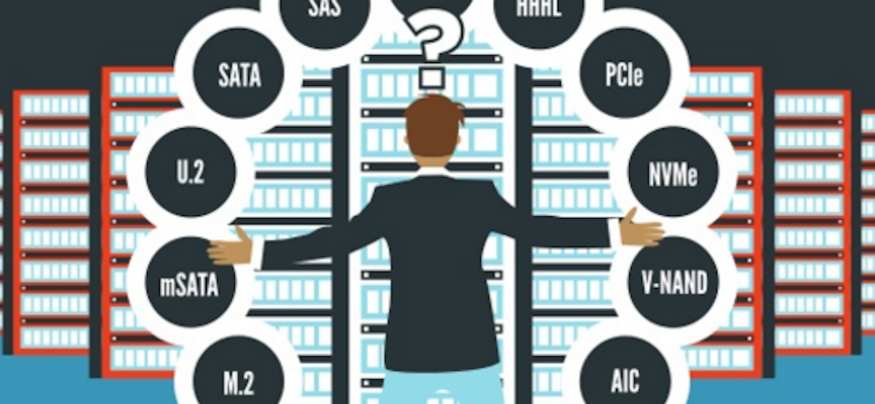Engineers are always looking for more speed, particularly when it comes to storage devices. Many of the most perceptible delays that users experience relate to storage drives, which for a long time saw relatively minor increases in speed. In the search for higher performance drives, the latest M.2 solid state drives (SSDs) featuring the PCIe interface have had a major boost in speed, while becoming much smaller at the same time.
SSD Form Factors
M.2 SSDs are the latest physical form factor and interface for solid state drives, and the first to eliminate the limitations of previous storage devices. The first SSDs were created in a form factor that mimicked 3.5-inch and 2.5-inch hard-disk drives (HDDs), with mounting screws in the same places and the same SATA interface to the motherboard.
As SSD performance grew rapidly, the SATA interface was revised to improve performance, but it still couldn’t keep up. The next evolution of SSD interfaces utilized PCI-express (PCIe) — the same interface used by graphics cards and other boards that plug directly into motherboards — and a version called U.2 that allows a 2.5-inch drives to plug into a PCIe slot via a cable attachment.
Sizes and Slots
M.2 SSDs were developed with mobile devices in mind, and the drives are offered in a variety of sizes. The M.2 SSDs can get quite small and still support PCIe, which allows these drives to work at maximum speed. The M.2 interface can have three parts: the “B” key, the “M” key and the central interface. The B and M keys will be different depending on the number of lanes of PCIe supported. These lanes determine the maximum speed of the device, with 4x PCIe reaching speeds traditional HDDs cannot.
Performance
An M.2 connector will have two 1x connectors, one 2x or one 4x connector. With a 4x connector, a drive can reach speeds of 31.5 GB/s, while even the 1x connection produces approximately 7 GB/s, a substantial improvement over even high-performance drives intended for servers. Since most motherboards made in the last couple years support the M.2 PCIe specification, there is no reason not to use M.2 drives, which offer two to five times the performance.
Power and Cooling
Electronic components for M.2 devices are surface mounted on a small circuit board, rather than encased in a 2.5-inch box, making the cooling process easier and more efficient. This is advantageous because cooler temperatures improve component efficiency and reduce power consumption. This is especially important in battery-powered mobile devices, but it is also a factor in computers that contain several drives.
Software Drivers
In addition to its size and the type of interface, SSDs needs software to communicate with the motherboard. The first generation of SSDs used the same software as HDDs at the time, the Advanced Host Controller Interface (AHCI). To address the differing requirements of SSDs compared with HDDs, the Nonvolatile Memory Express (NVMe) specification was created, along with the SATA Express specification, allowing both old AHCI and new NVMe drives to coexist in the same system.
NVMe helps systems get the most out of the newer, high-performance SSDs. Between NVMe and the PCIe 4x hardware interface, an M.2 SSD offers five to ten times the performance of first-generation SSDs. Drives such as the Samsung 950 Pro M.2 NVMe SSDs are achieving read speeds of 2,500 MB/s, compared to 300 MB/s or less with first-generation SSDs.
In addition to the raw speed, the NVMe bus also supports a greater number of commands and command queues. The latter lets the system line up storage requests, which is important because with modern multicore processors there can be dozens of requests from a program all trying to access storage at the same time. The old AHCI could only handle one queue with 32 commands per queue, while NVMe can handle 65,535 command queues and the same number of commands per queue.
The M.2 specification is finally bringing storage back to par with the advances in CPUs and memory over the last few years. While HDDs have not made enormous strides, SSDs, and in particular M.2 SSDs, have increased throughput and reduced latency by 500 percent or more. As electronic devices increasingly deal with more data in the form of videos, 3-D games and more, the improvements will help the devices keep up.
Take a look at the infographic below to see how M.2 SSDs with PCIe are aligned for speed.
M.2 SSDs: Aligned for Speed – Infographic from Samsung Business USA







